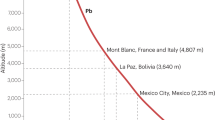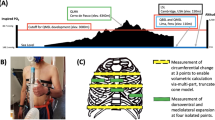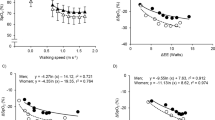Abstract
A VARIETY of adaptive mechanisms which aid in the physiological adjustment to the hypoxic environment of altitude have been reported in man1. Although visitors to high altitudes increase ventilation in response to environmental hypoxia, natives in the Andes and Himalayas show a blunted or absent ventilatory response to acute hypoxia both at rest and during exercise2–5. Adult high altitude natives in the Andes have larger lungs with a greater gas exchange surface, as judged by physiological tests of lung volume and diffusing capacity, than sea level natives or short term visitors at altitude6–9. Whether these respiratory adaptations in man are determined solely by environment or relate to genetic traits is uncertain. The age at which these pulmonary adaptations to hypoxia occur is not known, neither is it certain whether migrants to and from high altitude reversibly acquire these physiological changes. To investigate further the mechanism of pulmonary adaptations to chronic hypoxia and to clarify the position of genetic factors in this process, we undertook an expedition to Peru from April to August 1975. Control of ventilation and lung volumes were studied in different age groups, from neonatal period to adulthood, both at high altitude and sea level. It was found that the blunted ventilatory response to hypoxia and large lung volumes developed gradually after birth over a period of many years, and that the phenomena were at least partly reversible at sea level. The results showed that the adaptive response in respiratory physiology were determined by environmental rather than genetic factors.
This is a preview of subscription content, access via your institution
Access options
Subscribe to this journal
Receive 51 print issues and online access
$199.00 per year
only $3.90 per issue
Buy this article
- Purchase on Springer Link
- Instant access to full article PDF
Prices may be subject to local taxes which are calculated during checkout
Similar content being viewed by others
References
Lahiri, S., in Environmental Physiology (edit. by Robertshaw, D. D.), 271–311 (Butterworths, London, 1974).
Lahiri, S., and Milledge, J. S., Nature, 207, 610–612 (1965).
Severinghaus, J. W., Bainton, C. R., and Carcelen, A. Resp. Physiol., 1, 308–334 (1966).
Lefrancois, R., Gautier, H., and Pasquis, R. Resp. Physiol., 4, 217–228 (1968).
Lahiri, S., Kao, F. F., Velasquez, T., Martinez, C., and Pezzia, W. Resp. Physiol., 8, 361–374 (1970).
Hurtado, A. Am. J. phys. Anthrop., 17, 137–165 (1932).
Guleria, G. S., Pande, J. N., Sethi, P. K., and Roy, S. B., J. appl. Physiol., 31, 536–543 (1971).
Frisancho, R. A., Hum. Biol., 41, 365–379 (1969).
Cerney, F. C., Dempsey, J. A., and Reddan, W. G., J. clin. Invest., 52, 2993–2999 (1973).
Edelman, N. H., Lahiri, S., Braudo, L., Cherniack, N. S., and Fishman, A. P. New Engl. J. Med., 282, 405–411 (1970).
Sutherland, J. M., and Ratcliff, J. W., Am. J. Dis. Childh., 101, 67–74 (1961).
Brady, J. P., and Ceruti, E., J. Physiol., Lond., 184, 631–645 (1966).
Frisancho, R. A., Martinez, C., Velasquez, T., Sanchez, J., and Montoye, H., J. appl. Physiol., 34, 176–180 (1973).
Krüger, H., and Arias-Stella, J. Am. J. Obstet. Gynec., 106, 586–591 (1970).
Author information
Authors and Affiliations
Rights and permissions
About this article
Cite this article
LAHIRI, S., DELANEY, R., BRODY, J. et al. Relative role of environmental and genetic factors in respiratory adaptation to high altitude. Nature 261, 133–135 (1976). https://doi.org/10.1038/261133a0
Received:
Accepted:
Issue Date:
DOI: https://doi.org/10.1038/261133a0
This article is cited by
-
Comparing high versus low-altitude populations to test human adaptations for increased ventilation during sustained aerobic activity
Scientific Reports (2022)
-
Sleep and Breathing in Recreational Climbers at an Altitude of 4200 and 6400 Meters: Observational Study of Sleep and Patterning of Respiration During Sleep in a Group of Recreational Climbers
Sleep and Breathing (1999)
Comments
By submitting a comment you agree to abide by our Terms and Community Guidelines. If you find something abusive or that does not comply with our terms or guidelines please flag it as inappropriate.



